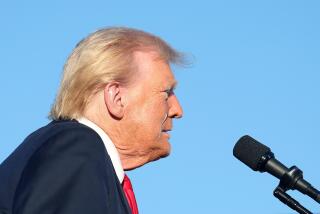Ex-FBI Agent Miller, Facing a Life Term, Goes on Trial Today
- Share via
The first FBI agent ever charged with espionage has maintained his innocence for months, while being lambasted by federal prosecutors as a liar, thief, adulterer, office bumbler and traitor.
While admitting to a long list of embarrassing blunders and misdeeds, Richard W. Miller has steadily maintained since his arrest last Oct. 2 that he never was and never planned to be a Soviet spy.
Miller’s story is that he became involved with convicted Soviet spies Svetlana and Nikolai Ogorodnikov in an effort to penetrate a Soviet spy ring and possibly salvage an otherwise dismal 20-year career with the FBI.
Today in a Los Angeles federal courtroom, Miller’s spy trial will finally begin, and it will be up to a jury to decide whether Miller is telling the truth.
Faces Life in Prison
The government claims that Miller’s story is just one more fabrication in a sordid patchwork of lies that covered past bribe-taking and repeated episodes of adultery and petty theft.
He is charged not only with conspiring to commit espionage with the Ogorodnikovs, but with actually passing secret FBI documents to Svetlana Ogorodnikova in exchange for sex, $65,000 in gold and cash and a Burberry’s trench coat.
If the jury, selected from a panel of 170 potential jurors, finds Miller guilty, he faces a maximum sentence of life in prison.
While the Ogorodnikovs abruptly ended their two-month spy trial June 25 in a plea-bargain arrangement, the attitude of Miller’s lawyers has been that Miller has nothing to lose by submitting his case to a jury.
Miller was the primary target of the FBI investigation that started late last August after it was first suspected that he might be involved with the Ogorodnikovs in an espionage conspiracy. And his lawyers believe there would be little chance of leniency if he pleaded guilty.
Lawyer Known as Fighter
“This case will be decided by the jury, and we look forward to the start of trial,” said Stanley Greenberg, one of the two defense lawyers representing the 48-year-old former counterintelligence agent.
Greenberg, a former U.S. attorney with a reputation as a scrappy courtroom fighter, is joined in Miller’s defense by Joel Levine, another skilled former federal prosecutor, who helped win the convictions of Christopher Boyce and Daulton Lee in a 1977 espionage case that inspired the book and movie, “The Falcon and the Snowman.”
From the time of the arrests of Miller and the Ogorodnikovs last October, Greenberg and Levine have been the most aggressive of the defense lawyers in the espionage case. One change from the Ogorodnikov’s trial in the coming Miller trial could be a more combative courtroom atmosphere.
U.S. Atty. Robert C. Bonner, prosecuting his first case since taking over the U.S. attorney’s office in early 1984, will personally head the prosecution team. Bonner, quick to explode in booming courtroom oratory when angry, will be joined by Assistant U.S. Atty. Russell Hayman.
Bonner and Greenberg will deliver the opening statements as Miller’s trial begins, in some respects a summer rerun of the Ogorodnikovs’ trial. There is little dispute over the chronology of events during the four-month period of Miller’s involvement with the Soviet emigre couple, but total disagreement over the interpretation.
As part of their plea bargain in June, Ogorodnikova was sentenced to 18 years in federal prison. Her husband received an eight-year sentence, which he has now decided to challenge, claiming that he pleaded guilty only because of coercion and to help his wife avoid a life sentence.
In pretrial documents filed last week, Bonner and Hayman said they plan to call more than 60 witnesses during Miller’s trial. There has been speculation that the government may call Ogorodnikova to testify against Miller, granting her the same immunity that Miller received for two weeks of testimony during the Ogorodnikov trial.
Whether Miller will testify remains one of the major unanswered questions. He has already testified twice before, first during preliminary hearings in January and then during the Ogorodnikov trial. He was generally viewed as a disastrous witness, and some trial sources have questioned the wisdom of a third appearance.
In pretrial maneuvering, it has become clear that Miller’s lawyers intend to revive the issue of whether Miller was the victim of the so-called Mormon Mafia at the top levels of the FBI’s Los Angeles office.
According to his lawyers, Miller, an excommunicated Mormon with a wife and eight children, was first coddled by his Mormon superiors, including Richard T. Bretzing, agent in charge of the Los Angeles office, but was then prosecuted with special vigor because of his church problems.
The issue was first raised during pretrial hearings in an effort to dismiss the charges against Miller, but U.S. District Judge David V. Kenyon rejected the claims. Nonetheless, Bretzing will be among the witnesses to testify against Miller. And his role in the Miller investigation will be sharply challenged by Greenberg and Levine.
Crucial Statements
Crucial to the government’s case are statements made by Miller to FBI agents during five days of questioning before his arrest. During that time, according to the FBI, Miller admitted passing documents to Ogorodnikova.
One of the documents allegedly passed to Ogorodnikova sometime during August, 1984, at Miller’s Lynwood residence was a copy of the FBI’s “Positive Intelligence Reporting Guide,” a classified document that reportedly gives a basic outline of U.S. intelligence targets.
Two of the FBI’s witnesses against Miller will be Graham W. Van Note and Larry E. Torrence, counterintelligence agents who helped supervise the FBI’s investigation of Miller and who questioned him last Oct. 1, the day before his arrest.
In court documents, Van Note and Torrence said that Miller not only admitted passing the documents to Ogorodnikova, but actually drew them a map to show the exact spot in his Lynwood house where she first viewed the FBI guide.
“Miller stated that on one occasion during August, when Ogorodnikova was at his Lynwood residence, he showed her a copy of the July, 1984, ‘Positive Intelligence Reporting Guide,’ ” they stated in written statements reconstructing their interview with Miller.
“Miller drew a sketched map of his home in which he pointed out (that) he and Ogorodnikova were standing near the doorway of his bedroom when he took the document from his briefcase on the dresser and showed it to her,” they said.
During their Oct. 1 interview with Miller, Van Note and Torrence said, Miller also admitted taking a copy of the FBI guide and another unidentified document with him on a trip with Ogorodnikova to the Soviet Consulate in San Francisco last Aug. 25. It was during that trip, the government contends, that Ogorodnikova turned the documents over to Soviet KGB officials.
“Miller continued that Ogorodnikova always asked for paper, and he took the documents to pacify her and to enhance his position with her and to assist in her recruitment of him,” the agents reported. “Miller stated he was unaware as to whether she actually took the documents into the Soviet Consulate. . . . He stated she had access both to the two documents and to his FBI credentials. He stated he knew he was out of line but had deluded himself.”
During pretrial hearings last week, Miller’s lawyers attempted to have the testimony of FBI agents about Miller’s pre-arrest statements ruled inadmissible. But Kenyon ruled that Miller had been properly advised of his rights to a lawyer before making the statements.
Miller’s trial is expected to last about two months.
More to Read
Sign up for Essential California
The most important California stories and recommendations in your inbox every morning.
You may occasionally receive promotional content from the Los Angeles Times.










